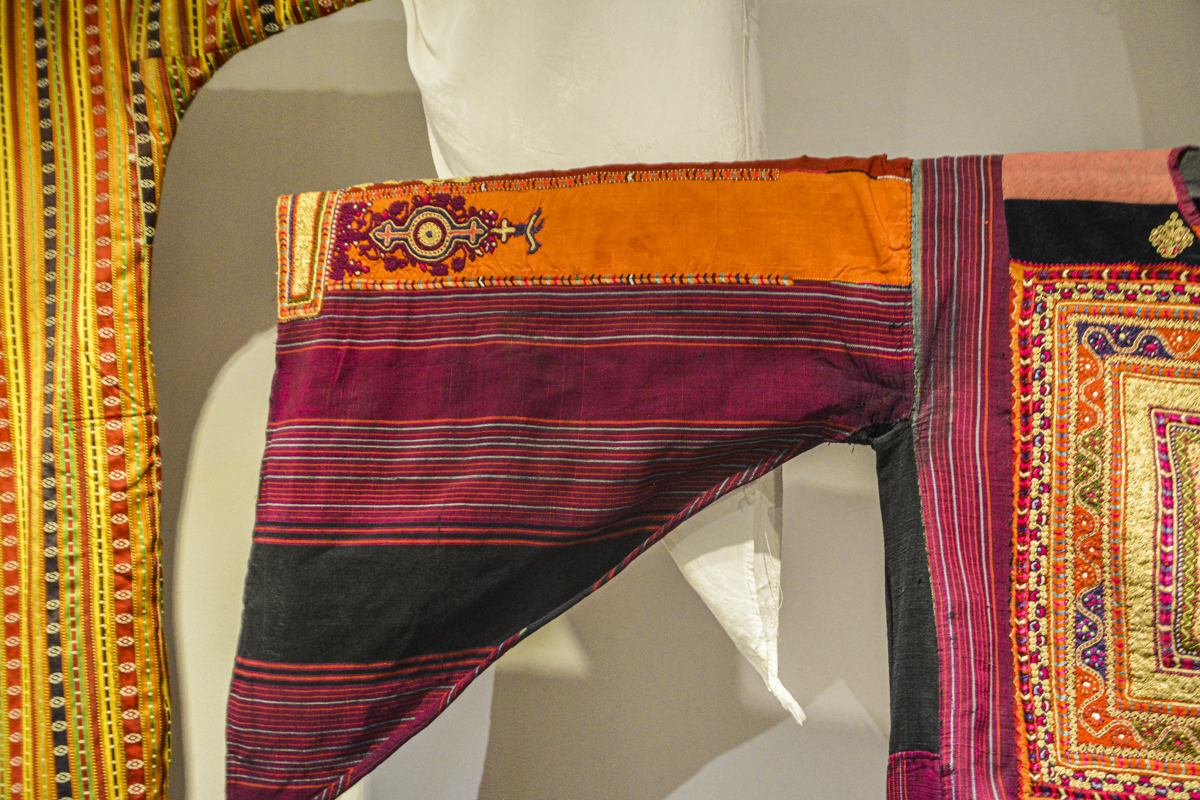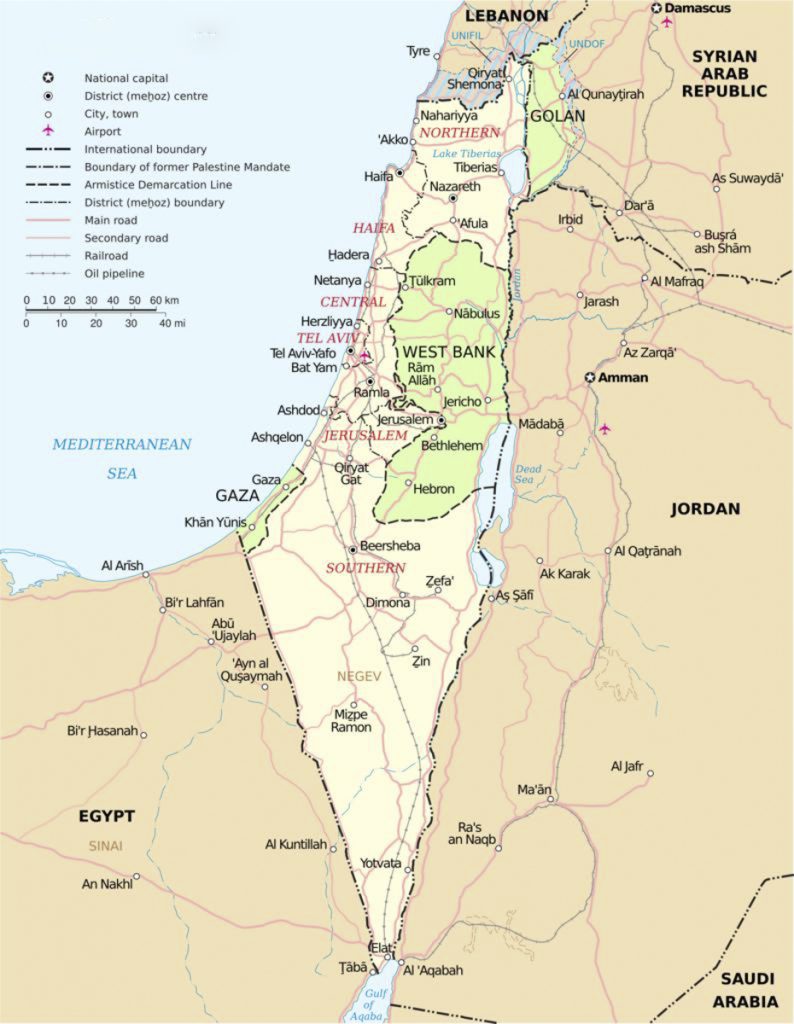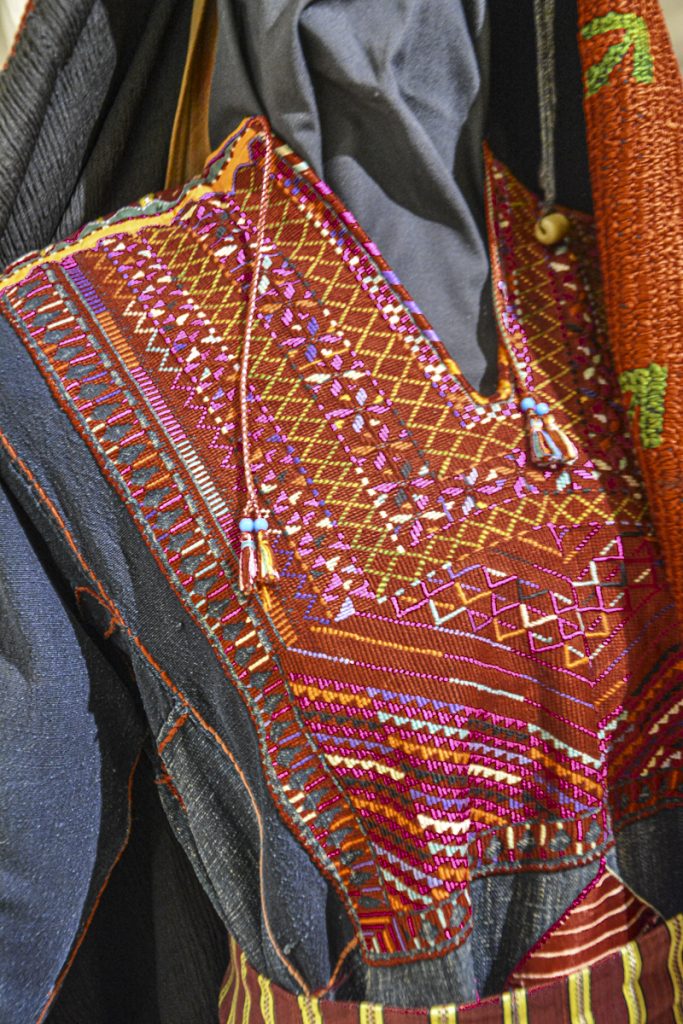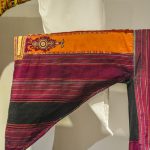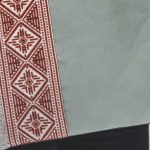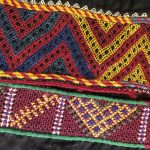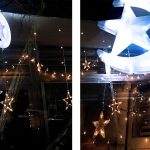Detail on the sleeves of Beit Laham’s thobe, including tiny crosses, a religious symbol.
ARABIC ARTICLE, ENGLISH TRANSLATION, & PHOTOS BY BATOOL AL-DULIGAN
Photos were taken at Tiraz Centre in Amman, Jordan. Special thanks to the centre’s staff for their help with the research for this article.
Palestine is located in the Eastern Mediterranean region, the cradle of civilization and monotheistic religions. Despite its small size, the country is full of people from different regions, backgrounds, and religions, a diversity reflected in the traditional costume of each region.
These regional costumes are distinctive and unique because of the varied raw materials used, the shape of their embroidery, and their particular fabric and thread colors. As a result, every region in Palestine has its unique thobe and embroidery that describe its citizens and their identities.
Starting from the north of Palestine, in Al-Jaleel (Galilee, in English), women often wore thobes made from cotton and silk without embroidery. Al-Jaleel’s thobes are made unique by their multiple colors, such as red, blue, yellow, green, and black. These thobes are comprised of two pieces: the white cotton underdress and the colorful, long dress over it.
In the southern West Bank city of Al-Khalil (Hebron, in English), thobes have geometric shapes embroidered in their front center panel. The extensive use of cross-stitch in the material, creating a masterpiece full of drawings, distinguishes Al-Khalil’s thobes from dresses in other regions. The people who created this traditional dress had an intuition to leave no empty spaces for additional needlework.
When it comes to Beit Laham (Bethlehem, in English), citizens had a different point of view. Influenced by European church leaders and the Ottoman Empire, this city was the first to use couching embroidery, called tahrera, instead of cross-stitch. Christian women there would stitch the cross in the middle of their thobes instead of wearing cross necklaces. Regarding the thobe color in this region, women preferred the combination of fuchsia, black, orange, and gold, unlike the women in the rest of Palestine who usually created black thobes decorated with different colors of embroidery based on the nature of the city—both its natural surroundings and the preferences of its citizens.
Moving to Ramallah, located north of Jerusalem, we find a unique and modern thobe that is one of the nicest in the region because of its beautiful beige color and red cross-stitch. It is completed with a distinctive headscarf full of coins. These coins were the wearer’s dowry, which is the money that the groom gives to the bride before getting married. In their point of view, a man should give his bride a specific amount of money because it was her right. It was considered rude if the husband asked the wife to give him some of the coins after the marriage. Women in Ramallah most likely wore their headscarves with their dowry to buy anything they needed or wanted.
In Gaza City on the western coast of Palestine, women’s thobes were black with red embroidery and fuchsia stripes that made the thobes more colorful and made them distinctive from black and red thobes in other cities. Because of the beauty of the fuchsia stripes in Gaza’s thobe, people in Al-Khalil asked them to stitch a good number of these fuchsia stripes on their thobes too, despite the huge number of drawings already present.
Ending our tour with the nomadic Bedouin in southern Palestine (in areas such as Beersheba), we learn that costumes in this area were divided into three types based on a woman’s marital status. Married women wore a fabulous, traditional black dress with plenty of colorful embroidery and some cowrie shells stitched into the dress to protect the wearer from envy. These wives also wore a burqa (face ornament) full of coins. Single and widowed ladies wore a black dress with little embroidery except on the lower skirt, which had dark blue cross-stitch, letting people know the marital status of these ladies. Women who wanted to marry or marry again wore a dress similar in style to the previous one except the lower skirt included some colorful shapes among the blue, making it obvious to everyone what this lady wanted without saying any word.
If you’re interested in learning Palestinian embroidery, Tatreez & Tea offers online classes.
Be sure to read the first article of this series, published Monday, and then watch on Friday for the final article where you’ll learn about the unique aspects of traditional thobes in Jordan.
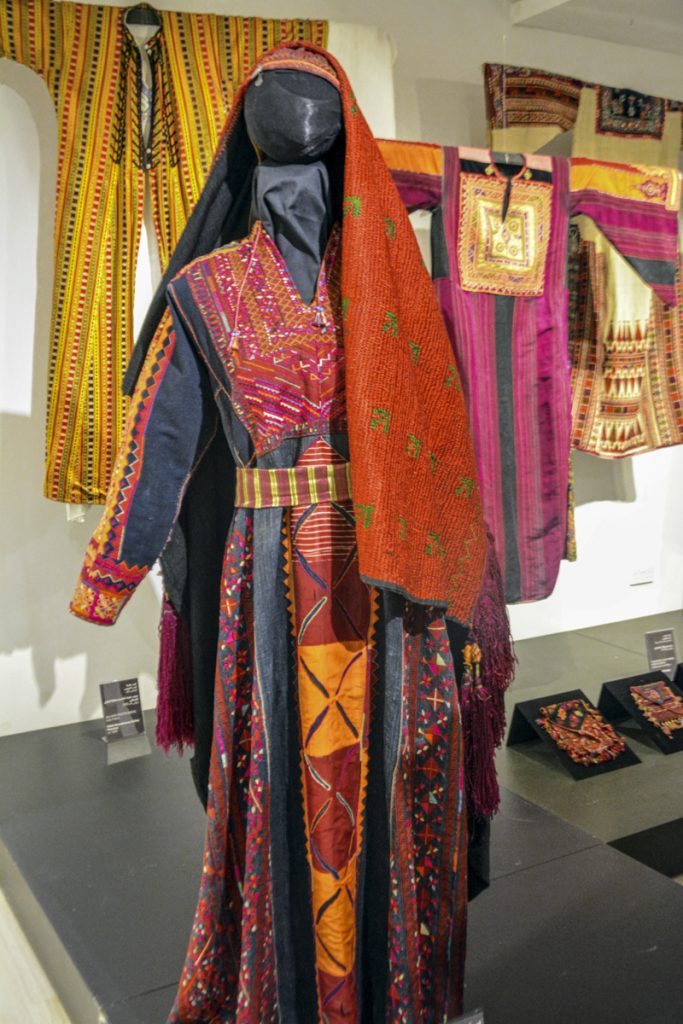
Thobe and headband from Al-Khalil (Hebron) in Palestine.
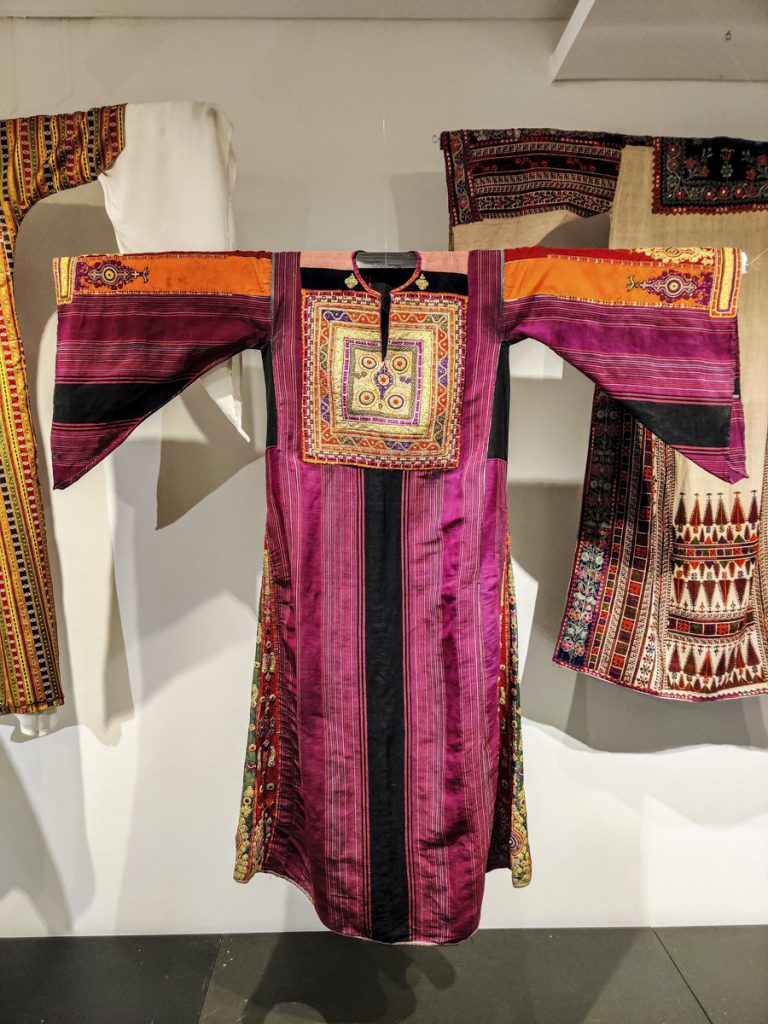
Thobe from Beit Laham (Bethlehem) in Palestine.
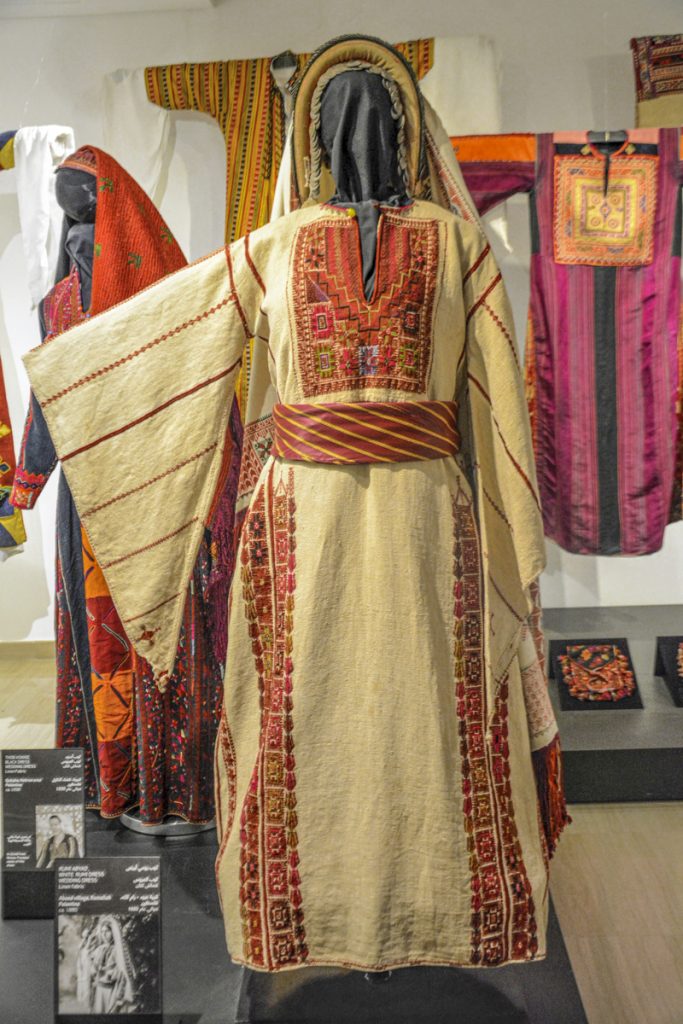
The thobes in Ramallah, in central Palestine, were a unique, flax-colored fabric, and the headdresses were lined with coins.
الزي التراثي الفلسطيني
تقع دولة فلسطين في منطقة الشرق الأوسط، حيث انها تعتبر مهد الحضارات ومهد الأديان، إذ تتميز باحتوائها على تنوع ثقافي عظيم في داخل المنطقة بسبب تعدد المدن وسكانها وأديانها وفي معظم الأحيان ينعكس هذا التنوع على الزي التراثي لكل منطقة.
إن الزي التراثي في فلسطين مختلف تماما وفريد من نوعه بسبب المواد الخام التي تم استخدامها في تصنيع الأثواب قديما، وبسبب شكل التطريز المميز الذي يستخدمونه وهو على شكل اشارة الضرب، إضافة إلى تطريز التحريرة المشهور في بعض مناطق الدولة، وأخيرا يرجع السبب إلى ألوان الأثواب المميزة وألوان الخيوط الذي يحيكون بها الأثواب والتطريزات، لذلك فإن لكل مدينة في فلسطين ثوب وتطريز يميزها ويميز مواطنيها وهوياتهم.
بداية من شمال فلسطين حيث تقع مدينة الجليل. مواطنوا هذه المنطقة يرتدون الأثواب المصنوعة من الحرير والقطن من دون وجود أي نوع من أنواع التطريز التي تزين الثوب، حيث إن الشيء الوحيد الذي يجعل من ثوب الجليل ثوبا مميزا ورائعا هو تداخل الألوان الجميل في القطعة الخارجية من الثوب كالأحمر، والأزرق، والأصفر، والأخضر، والأسود. إن هذه الأثواب تتكون من قطعتين؛ الثوب الأبيض من الداخل والثوب الملون من الخارج.
انتقالا إلى مدينة الخليل، حيث تتميز أثواب هذه المدينة بالتطاريز الموجودة على الثوب الأسود والأشكال الهندسية التي تزين الثوب من الوسط. إن الذي يجعل من هذا الثوب قطعة فريدة من نوعها هو الاستخدام المكثف للتطاريز المعروفة بشكل اشارة الضرب والذي تجعل من هذا الثوب لوحة فنية راقية جدا مليئة بالرسومات والالوان. إن الأشخاص الذي يصنعون الثوب الخليلي غالبا يكون لديهم النية بعدم ترك أي مساحة فارغة من دون تطريز وهذا ما يجعله مختلفا عن بقية الأثواب في بقية المناطق.
أما بالنسبة لمنطقة بيت لحم في فلسطين، فالمواطنين هناك لديهم صورة مختلفة تماما عندما يتعلق الأمر بالزي التراثي والأثواب، إذ إن هذه المدينة هي المدينة الأولى التي تستخدم تطريز التحريرة في فلسطين حيث أنهم تأثروا بكهنة الكنائس في أوروبا بجانب تأثرهم بالدولة العثمانية. إن النساء في تلك المنطقة تعمل على تطريز الصليب في منتصف الثوب من جهة القبة بدلا من ارتداء الصليب على هيئة سلسلة تضعها في رقبتها. فيما يتعلق بألوان الثوب، فيفضل النساء استخدام المزيج بين اللون الفوشي والاسود والبرتقالي والذهبي مقارنة بالنساء الفلسطينيات من مدن مختلفة واللواتي يفضلن اللون الأسود للثوب بالإضافة إلى ألوان التطاريز المختلفة بناء على طبيعة المنطقة.
مرورا برام الله، حيث يعتبر ثوب رام الله من الأثواب الجميلة والعصرية في تلك الحقبة، إذ يعتبر واحد من أجمل الأثواب الفلسطينية إذ يتميز بلونه البيج الممزوج بالتطريز الأحمر إضافة إلى غطاء الرأس المملوء بالنقود المعدنية الفضية. إذ تعتبر هذه النقود مهر الفتاة الذي يعطيه الرجل للفتاة قبل الزواج. حيث إن الرجل يعتبر مسؤول عن إعطاء مبلغ محدد من النقود للفتاة قبل الزواج ومن العيب والوقاحة أن يطلب منها ان تعطيه بضعا منهم بعد الزواج؛ فترى المرأة تنزل إلى السوق بعصبتها المملوءة بالنقود بحيث إذا أرادت أن تشتري شيء بإمكانها أن تأخذ من النقود الموجودة على رأسها.
أما بالنسبة لمدينة غزة، فالنساء هنالك يرتدون الثوب الأسود المطرز باللون الأحمر والمضاف إليه تلك اللمسة الغزاوية المميزة المتمثلة بخط عريض باللون الفوشي والبنفسجي مما يجعل من ذلك الثوب قطعة في غاية الجمال، ومن جمالها سعى الخليليون بأن يأخذو هذه القطعة العريضة الفوشية من مدينة غزة حتى يضعوها على ثوبهم على الرغم من عدم وجود أي مكان فارغ لوضع أي من التطاريز عليه. ولكن جمالية هذه القطعة وحرفيتها جعلت من الخليليون عشاقا لهذه الاضافة الرائعة من مدينة غزة.
انتهاءً بالجهة الجنوبية من فلسطين حيث يقطنون بدو بئر السبع، إن الأزياء الشعبية في هذه المنطقة تنقسم لثلاثة أقسام بناءً على الوضع الاجتماعي للمرأة؛ النوع الأول كان من نصيب المرأة المتزوجة، يتميز رداء المرأة المتزوجة باللون الأسود المليء بالتطاريز الملونة باللون الأحمر والأزرق والأصفر إضافة إلى استخدم الصدف الغجري بالتطريز لظنهم بأنه يحمي من الحسد والعين. ويستخدم النساء المتزوجات أيضا البرقع المزين بالنقود المعدنية التي تغطي وجه المرأة. أما النوع الثاني فكان من نصيب الفتاة العزباء والأرملة إذ يتميز الثوب بلونه الأسود المطرز صدره، إضافة إلى اللون الأزرق الغامق الذي يزين أسفل الثوب ليدل على أن هذه الفتاة عزباء أو أرملة. وآخراً هو النوع الثالث الذي يصف المرأة الأرملة التى ترغب بالزواج مرة أخرى حيث تعمل النساء في هذه المنطقة على إدخال القليل
Batool Al-Duligan is an Arab writer living in Amman, Jordan. She received her Bachelor of Arts degree in Applied English-Linguistics from the University of Jordan and her training in translating news articles at the Jordan News Agency in Amman. She is an opinion writer and columnist at Sasa Post and a marketer at Souq Fann, an e-commerce website and social enterprise that supports the local community and offers new opportunities for craftsmanship in Jordan.

